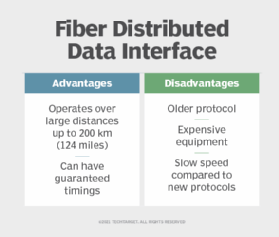FDDI (Fiber Distributed Data Interface)
What is FDDI (Fiber Distributed Data Interface)?
FDDI (Fiber Distributed Data Interface) is a network standard that uses fiber optic connections in a local area network (LAN) that can extend in range up to 200 kilometers (124 miles). The FDDI protocol is based on the token ring protocol. A FDDI LAN can support thousands of users. While FDDI is frequently used on the backbone for a wide area network (WAN) or campus area network (CAN), it has been largely superseded by other networking technologies.
Fiber Distributed Data Interface topology and design
A FDDI network contains two token rings: a primary ring and a secondary ring that is used as a redundant backup. The primary ring offers up to 100 megabits per second (Mbps) capacity, while the secondary ring can also be used to carry data, increasing capacity to 200 Mbps. One ring will operate in a clockwise direction and the other in a counterclockwise direction. The single ring can extend the maximum distance of 200 km (124 miles); a dual ring can extend 100 km (62 miles). Users can connect thousands of devices to a single FDDI network.
Although the FDDI topology is a token ring network, users may also implement it in a star topology structure. FDDI is derived from the Institute of Electrical and Electronics Engineers 802.4 token bus timed token protocol.
In a token network, only the device with the token may transmit. The use of a timed token ensures the maximum wait time for each device to be able to transmit. Depending on the network latency requirements, users can configure FDDI as synchronous with guaranteed timings for latency-sensitive networks or as asynchronous, which does not rely on strict token timings.
FDDI is a product of the American National Standards Committee X3T9 standard and operates on Open Systems Interconnection model Layer 1 (physical) and Layer 2 (media access control data link). It has a large maximum transmission unit frame size of 4,352 bytes.
Single-mode fiber optic cable is FDDI's primary interconnect medium. FDDI standards using nonfiber optic cable also exist, such as Copper Distributed Data Interface, Twisted-Pair Physical Medium-Dependent or Twisted-Pair Distributed Data Interface.
In a FDDI network, users attach the primary routers and devices to both rings of the network. These nodes are called dual attachment stations. Users can also connect other nodes via a single fiber optic connection; these are called single attachment stations. FDDI can also be interconnected to other types of networks using other protocols, thereby creating a larger WAN or interconnecting many clients.

Fiber Distributed Data Interface history and use
Developed in the late 1980s, FDDI was a good option for large CANs and metropolitan area networks. Its relatively high speed of 100 Mbps was much better than 10 Mbps for standard Ethernet. Users could also deploy FDDI in a single server room to interconnect servers to a single backbone network.
FDDI-II is a version of FDDI that adds the capability to add circuit-switched service to a network so that voice and video signals can also be handled. Work is underway to connect FDDI networks to the developing Synchronous Optical Network offered as leased fiber optic lines.
Other networking standards have largely superseded FDDI. For example, Fast Ethernet offers the same speed at lower cost for the installation, while organizations generally use Gigabit Ethernet and 10 Gigabit Ethernet server or workstation interconnects. Meanwhile, fiber to the workstation or passive optical networks are replacing high-speed connections for end devices, and newer fiber optic standards offer higher speeds for backbone interconnects.








